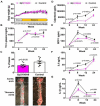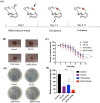Properties of Poly (Lactic-co-Glycolic Acid) and Progress of Poly (Lactic-co-Glycolic Acid)-Based Biodegradable Materials in Biomedical Research
- PMID: 36986553
- PMCID: PMC10058621
- DOI: 10.3390/ph16030454
Properties of Poly (Lactic-co-Glycolic Acid) and Progress of Poly (Lactic-co-Glycolic Acid)-Based Biodegradable Materials in Biomedical Research
Abstract
In recent years, biodegradable polymers have gained the attention of many researchers for their promising applications, especially in drug delivery, due to their good biocompatibility and designable degradation time. Poly (lactic-co-glycolic acid) (PLGA) is a biodegradable functional polymer made from the polymerization of lactic acid (LA) and glycolic acid (GA) and is widely used in pharmaceuticals and medical engineering materials because of its biocompatibility, non-toxicity, and good plasticity. The aim of this review is to illustrate the progress of research on PLGA in biomedical applications, as well as its shortcomings, to provide some assistance for its future research development.
Keywords: PLGA; applications; biodegradable; drug delivery; synthesis.
Conflict of interest statement
The authors declare no conflict of interest.
Figures












Similar articles
-
Recent applications of PLGA based nanostructures in drug delivery.Colloids Surf B Biointerfaces. 2017 Nov 1;159:217-231. doi: 10.1016/j.colsurfb.2017.07.038. Epub 2017 Jul 28. Colloids Surf B Biointerfaces. 2017. PMID: 28797972 Review.
-
Customizing poly(lactic-co-glycolic acid) particles for biomedical applications.Acta Biomater. 2018 Jun;73:38-51. doi: 10.1016/j.actbio.2018.04.006. Epub 2018 Apr 11. Acta Biomater. 2018. PMID: 29653217 Review.
-
A Regio- and Stereoselective Ring-Opening Polymerization Approach to Isotactic Alternating Poly(lactic-co-glycolic acid) with Stereocomplexation.Angew Chem Int Ed Engl. 2025 Feb 24;64(9):e202422147. doi: 10.1002/anie.202422147. Epub 2025 Jan 31. Angew Chem Int Ed Engl. 2025. PMID: 39831782
-
Redefining the importance of polylactide-co-glycolide acid (PLGA) in drug delivery.Ann Pharm Fr. 2022 Sep;80(5):603-616. doi: 10.1016/j.pharma.2021.11.009. Epub 2021 Dec 9. Ann Pharm Fr. 2022. PMID: 34896382 Review.
-
Progress in the drug encapsulation of poly(lactic-co-glycolic acid) and folate-decorated poly(ethylene glycol)-poly(lactic-co-glycolic acid) conjugates for selective cancer treatment.J Mater Chem B. 2022 Jun 8;10(22):4127-4141. doi: 10.1039/d2tb00469k. J Mater Chem B. 2022. PMID: 35593381 Review.
Cited by
-
Gene-Activated Materials in Regenerative Dentistry: Narrative Review of Technology and Study Results.Int J Mol Sci. 2023 Nov 13;24(22):16250. doi: 10.3390/ijms242216250. Int J Mol Sci. 2023. PMID: 38003439 Free PMC article. Review.
-
Biliary stents for active materials and surface modification: Recent advances and future perspectives.Bioact Mater. 2024 Sep 13;42:587-612. doi: 10.1016/j.bioactmat.2024.08.031. eCollection 2024 Dec. Bioact Mater. 2024. PMID: 39314863 Free PMC article. Review.
-
Hydrogel Microneedles with Programmed Mesophase Transitions for Controlled Drug Delivery.ACS Appl Bio Mater. 2024 Mar 18;7(3):1682-1693. doi: 10.1021/acsabm.3c01133. Epub 2024 Feb 9. ACS Appl Bio Mater. 2024. PMID: 38335540 Free PMC article.
-
Design and Synthesis of Biomedical Polymer Materials.Int J Mol Sci. 2024 May 7;25(10):5088. doi: 10.3390/ijms25105088. Int J Mol Sci. 2024. PMID: 38791127 Free PMC article.
-
Mesenchymal stem cell-delivered paclitaxel nanoparticles exhibit enhanced efficacy against a syngeneic orthotopic mouse model of pancreatic cancer.Int J Pharm. 2024 Dec 5;666:124753. doi: 10.1016/j.ijpharm.2024.124753. Epub 2024 Sep 24. Int J Pharm. 2024. PMID: 39321899
References
-
- Jašo V., Glenn G., Klamczynski A., Petrović Z.S. Biodegradability study of polylactic acid/ thermoplastic polyurethane blends. Polym. Test. 2015;47:1–3. doi: 10.1016/j.polymertesting.2015.07.011. - DOI
Publication types
LinkOut - more resources
Full Text Sources

